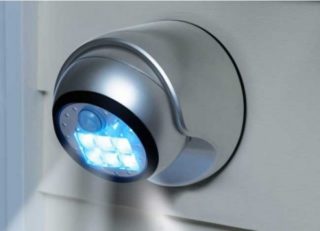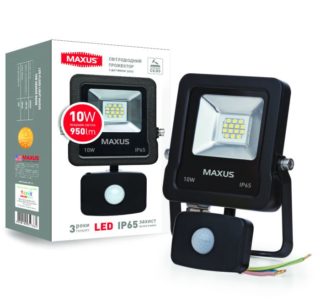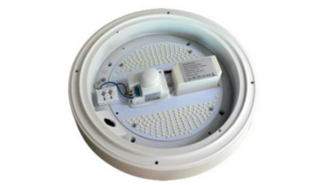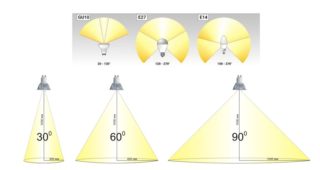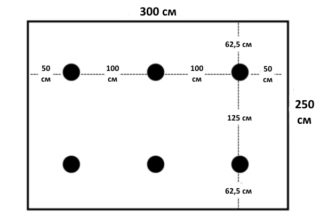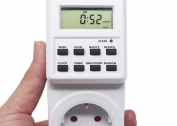Energy conservation is one of the main tasks that people are trying to cope with. For this, energy-saving devices and automation systems are used. You can save energy on the lighting group by switching to LED lamps with a motion sensor for the home. This device only works when someone is in the room, and turns off when the room is empty. Lamps with a motion sensor are used in living rooms, in offices and in enterprises.
The principle of operation and purpose
The LED lamp with a motion sensor works automatically. It scans the area of space that enters their visibility zone, and captures movement in it in various ways. An impulse causes a circuit to close, causing the lamp to light up. If there is no movement, the circuit turns off and the light goes out.
A quality lamp should have a number of features:
- Do not respond to small or medium pets.
- Disconnect after leaving all people.
- Ability to set a time interval.
- Work only in the absence of a sufficient level of lighting.
Such devices are wired and wireless. They can be equipped with other sensors - for example, a photo relay, which will turn on the lamp only in the evening or at night.
It is recommended to use LED lamps to work with the motion sensor. This is due to their energy efficiency, economy, safety, and long service life. They cost more than ordinary lamps, but quickly pay off during operation.
Types of LED Downlights
There are different classifications of LED devices. According to the intended purpose:
- Street lights. Parks, alleys, streets are highlighted.
- LED spotlights. They have great power, increased sensitivity. They are placed at especially important protected sites.
- Lamps with a sensor. They are placed in apartments and houses, as well as on stairwells and in the entrance.
The motion sensor can be built into the lamp itself or in a separate housing, which is placed at a distance from the lamp.
By the method of power, wired and wireless devices are isolated. Wired connects directly to the wiring, while the wireless receives energy from batteries or battery. Products powered by the outlet are placed in the rooms of frequent use - kitchen, bathroom, toilet, corridor. Autonomous models are placed in garages, closets, pantries, landings.
Design of fixtures with DD
Design features depend on the purpose of the lamp. Outdoor devices must be adequately protected against aggressive environmental influences.
Home models are used only inside the house. Searchlights can be installed both outdoors and indoors.
On sale you can find a cartridge in which a motion sensor is integrated. It can be screwed into any lighting device instead of a standard lampholder or installed in it. Then the device will act as an adapter.
Specifications
The main technical parameters of LED light sources with a motion sensor include:
- Power. Affects lighting and energy consumption.
- Colour temperature. Gives either cold, warm, or neutral white light.
- Dispersion angle.
- The number of LEDs in the housing.
- Working temperatures.
- Working voltage.
- IP protection class.
The characteristics of the detector itself must also be taken into account:
- Sensitivity.
- Viewing angle.
- Ability to work in extreme weather conditions.
- Working temperatures.
- Power.
- Levers for adjusting parameters.
The most expensive devices include ceiling lights with a maximum viewing angle, working in all directions.
How to place lamps on the ceiling
The most uniform lighting throughout the room is the main task of the lamp, regardless of the presence or absence of a motion sensor in the design. Therefore, the first step is to draw up a layout diagram and calculate the required number of lamps.
When creating the layout of the LEDs on the ceiling, you need to use the following recommendations:
- On 1 sq.m. the living room must have at least 3 watts of lighting. In the bathroom and bedroom - 2 W / sq.m., In the corridor 1 W / sq.m. In the children's room, the lighting level should be 8 watts per 2 sq.m. This is due to the presence of a play area and a workplace in the room.
- Accommodation depends on the individual characteristics of the room. In the bathroom, the lamps are placed around the perimeter at an equal distance from each other. In the living room is a central chandelier and several spotlights along the walls. Similarly done in the bedroom, but the light should be dim.
- In the presence of wall cabinets, the lamps must be moved 20 cm from the edge of the subject to the center of the room.
It is important not to forget about the power of light sources. For stretch ceilings, this value should not exceed 35 W, so as not to deform the canvas.
Installation and setup
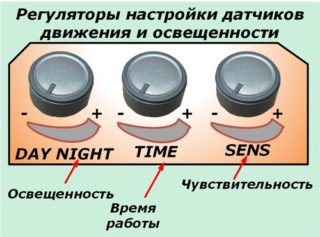 After buying a lamp, you need to carefully study the instructions and follow the proposed algorithm. The whole procedure is straightforward, so you can do it yourself.
After buying a lamp, you need to carefully study the instructions and follow the proposed algorithm. The whole procedure is straightforward, so you can do it yourself.
Connection steps are as follows:
- Choosing an installation location.
- Power outage on switchboard.
- Connecting a standard type key switch.
- Connection of the lamp to the contacts of the switch and the network. Grounding installation as needed. The wires must be connected in accordance with the marking.
- Isolation of junction points.
- Setting up the sensor. It is carried out by turning the corresponding levers. Settings are made in accordance with the requirements of the user and depend on the individual characteristics of the room.
Stand-alone wireless models connect in the same way, but battery terminals are used instead of the industrial network.
Terms of Use
To maintain the operability of the device during the stated period, it is necessary to observe the correct operation. The main requirements include:
- Avoid frequent operation.
- Clean the lampshade.
- Disconnect the device from the network when damage and defects are detected.
To reduce the number of false positives, it is impossible to put a lamp with a light sensor next to heating and air conditioning systems, near a place of traffic and near trees.
